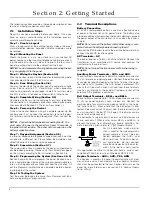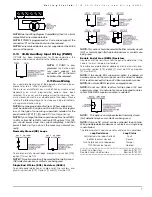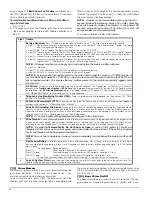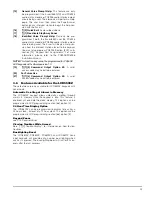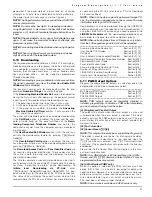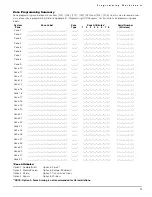
16
Section 5: Program Descriptions
The following section explains the operation of all programma-
ble features and options and provides a summary of all corre-
sponding programming locations.
5.1
Programming Security Codes
There are three codes which can be programmed by the
installer in the installer programming function: the
Master Code
,
the
Installer’s Code
, and a
Maintenance Code
. All other access
codes can be programmed through the [*][5] command. (see
“[*][5] Programming Access Codes”
)
The master code can also be programmed by the user as
access code (40). If the
Master Code Not Changeable
option
is enabled, the system master code can only be changed by
the installer.
The maintenance code can only be used to arm and disarm
the system. The maintenance code cannot bypass zones; use
[*][9] to arm the system, cancel auto-arming, or perform [*][7]
command functions. There will be no arm/disarm bell
squawks when the maintenance code is used.
General access codes can arm and disarm the system. When
the
Code Required for Bypassing
option is enabled, users
will need to enter a valid access code when bypassing zones.
Individual access codes can have the Zone Bypassing
attribute disabled under Access Code Attribute programming.
(see
“[*][5] Programming Access Codes”
)
If the
6-Digit User Access Codes
option is enabled, all the
access codes can be programmed with six digits instead of
four, with the exception of the panel ID code and the down-
loading access code.
Installer’s Code . . . . . . . . . . . . . . . . . . . . . . . . . Section [006]
Master Code . . . . . . . . . . . . . . . . . . . . . . . . . . . Section [007]
Maintenance Code . . . . . . . . . . . . . . . . . . . . . . Section [008]
Master Code Not Changeable . . . . . . . . . . Section [015]: [6]
Code Required for Bypassing . . . . . . . . . . Section [015]: [5]
6-digit User Access Codes . . . . . . . . . . . . . Section [701]: [5]
5.2
Zone Programming
Zones 1-8 are enabled by default. Disable unused zones, or
enable additional zones in programming sections [202] - [205].
The zone definitions describe how each of the zones you use
will operate. Program a two-digit code describing the zone
definition in sections [001] - [004]. Select a definition from the
list below.
In addition, each zone has eight different attributes which can
be programmed in sections [101] to [132]. (see 5.3
“Zone
Attributes”
)
Zone Definitions
[00] Null Zone
The zone is vacant. Unused zones should be programmed as
Null zones.
[01] Delay 1 Zone
This zone type, normally used for entry/exit doors, can be vio-
lated during the exit delay time without causing an alarm.
Once the exit delay has expired, opening the zone will start
the entry delay timer. During the entry delay time, the keypad
buzzer will sound steadily to advise the user that the system
delay should be disarmed. If the panel is disarmed before the
entry time expires, no alarm will be generated.
[02] Delay 2 Zone
The Delay 2 entry delay time can be set independently of
Delay 1 in programming section [005] (System Times).
[03] Instant Zone
This zone type will cause an instant alarm if it is violated when
the panel is armed. Typically, this zone is used for windows,
patio doors or other perimeter zones, and glassbreak detectors.
[04] Interior Zone
This zone will not cause an alarm if violated during the entry
delay. If the zone is violated before the entry delay has begun,
it will cause an instant alarm. Typically, this zone is used for
interior protection devices, such as motion detectors.
[05] Interior Stay/Away Zone
This zone type works similarly to the Interior zone type, except
that it will be automatically bypassed under the following con-
ditions:
•
When the panel is armed in the Stay Mode. (see 3.5
“Func-
tion Keys”
)
•
When the panel is armed without entry delay. (see
“[*][9]
Arming Without Entry Delay”
)
•
When the panel is armed with an access code and a Delay
type zone is NOT tripped during the exit delay.
The automatic bypass prevents the user from having to manu-
ally bypass Interior zones when arming at home. This zone is
typically used for interior protection devices, such as motion
detectors.
[06] Delay Stay/Away Zone
This zone type will operate similarly to Interior Stay/Away
zones, except that it will always provide an entry delay. Typi-
cally, this zone is used for interior protection devices, such as
motion detectors. This zone option will help prevent false
alarms since it always provides an entry delay time for the
user to turn off the panel.
NOTE:
Hardwired motion detectors covering entry/exit doors
that are using wireless transmitters must be programmed as
Delay Stay/Away. If not, the panel may see the motion detector
violation before the entry/exit transmitter has time to transmit to
the receiver, causing a false alarm.
[07] Delayed 24 Hour Fire Zone
NOTE:
Do not wire Fire zones on keypad zone terminals if the
DEOL supervision option is enabled for the panel (see Pro-
gramming Worksheets, section [013], option [2]).
When this zone is violated, the alarm output will be immedi-
ately activated (pre-alert) but the communicator will be
delayed for 30 seconds. If the user presses any key on any
keypad during this delay, the alarm output and the communi-
cator will be delayed an additional 90 seconds, giving the
user time to correct the problem. If the zone is still violated
after the 90 second delay, the panel will sound the alarm out-
put and delay the communicator for 30 seconds.
If the user does not press a key during the 30 second pre-
alert, the alarm output will latch and the panel will communi-
cate the alarm to the central station. The alarm will sound until
the Bell Cutoff time expires (Section [005] ‘System Times’), or
until a code is entered. (see 5.13
“Bell”
)
NOTE:
If a second fire zone is violated or if the fire keys are
pressed during the delay period, the panel will latch the alarm
output and will immediately communicate the alarm.



